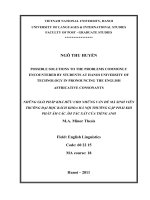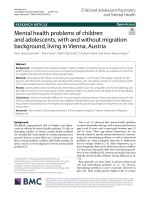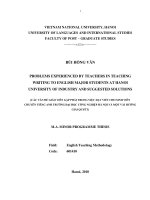Understanding About Mental Health Problems Of Espd Students At Hanoi University.pdf
Bạn đang xem bản rút gọn của tài liệu. Xem và tải ngay bản đầy đủ của tài liệu tại đây (2.38 MB, 20 trang )
<span class="text_page_counter">Trang 1</span><div class="page_container" data-page="1">
Do Thi Thu Hang – 4Q19 Doan Ha Ly - 4Q19Do Mai Anh - 4Q19Ha Thu Ha - 1Q19Duong Le Thuy – 4Q18Bui Thi Huyen Trang – 4Q19
</div><span class="text_page_counter">Trang 2</span><div class="page_container" data-page="2"><b>Table of content</b>
<b>Abstract</b><i><b>II.Research purpose...4</b></i>
<i><b>III.Research questions...5</b></i>
<i><b>IV.Research methodology...5</b></i>
<b><small>1.Research design...5</small></b>
<b><small>2.Types of data...5</small></b>
<b><small>3.Population & sample...5</small></b>
<b><small>4.Data collection procedures...6</small></b>
<b><small>5.Data analysis procedures...6</small></b>
<b><small>6.Ethical issues...7</small></b>
<i><b>V.Background information...7</b></i>
<i><b>VI.Literature review...8</b></i>
<i><b>VII.Finding and discussion...9</b></i>
</div><span class="text_page_counter">Trang 3</span><div class="page_container" data-page="3">Every year, Hanoi University enrolls more than 1200 students into theESPD faculty to learn English, as a prerequisite for students to studyspecialized subjects that are taught entirely in English. While learningisn't always easy at all levels, we believe first-year students face someunique challenges. Students must completely change their learningenvironment, make new friends, and learn new teaching methods. Somestudents must relocate away from their families to live and study inanother province. The purpose of this study is to look into the causes ofmental health problems among ESPD students at Hanoi University.Furthermore, this study investigates the effects of mental health issues onstudents' lives and studies. To answer the research question, we invited35 students from the ESPD department at Hanoi University. We analyzethe causes and effects of mental health problems based on the responseswe receive. According to our research: academics, finances, work, andrelationships with friends and family are all factors that contribute toESPD students' mental health problems. And these mental issues have asignificant impact on students' physical and mental health. Werecommend that Hanoi university organize activities to listen to andsupport freshmen in order to assist them in quickly adjusting to the firststage of their university program as well as the start-up phase ofadulthood.
3
</div><span class="text_page_counter">Trang 4</span><div class="page_container" data-page="4">Adapting to a new environment is certainly not easy, especially for new students. With a dynamic and open environment like the university environment, many extracurricular activities, large and small events require new students to have an ability to integrate and adapt quickly. If you don't adapt to those jobs, you will be isolated in these dynamic environments. Because not everyone has the ability to adapt well to a new environment, fresh students can completely suffermental shocks. This may stem from academic pressure, financial problems, difficulty in adaptingto a new environment, conflict in relationships, etc., leading to students dropping out or being forced to drop out happens very commonly. Statistics show that up to 48.2% of students are stressed, of which about 7% are severely stressed and easily leads to other psychological problems such as depression or anxiety. This paper aims to provide the status and causes of mental health problems in ESPD students. Then, the persistent nature of mental health problems ESPD students and their implications are summarized.
We are interested in learning more about the status of Hanu's ESPD students' mental health so weare conducting fundamental research on mental health issues in ESPD students at HANU. Thegoals of our study are whether ESPD students had mental health problems, and what they are;then identify the causes and consequences of mental health. This research acquires newknowledge and discovers phenomena that may be helpful in reality. With the introduction of newinformation about students' mental health problems, we hope that this research paper cancontribute to laying the foundation for this problem at Hanoi University. We also hope thisresearch can help the administrators of Hanoi University in coming up with solutions to thisproblem to help and improve the quality of students’ learning and students' lives.
1. Do ESPD students have mental health problems? What mental health problems do they have?2. What are the factors that contribute to the mental health problems of ESPD students?3. What are the consequences of having mental health problems in ESPD students?
</div><span class="text_page_counter">Trang 5</span><div class="page_container" data-page="5">This research study was conducted on ESPD students (including 9 specialized faculties) as atarget group since they have been affected by both environmental change factors and the hardstudy program. The number of interviewees are 35 students who come from different facultiesand are selected by observation or sharing.
First and foremost, with the qualitative method, we sample based on the convenience oraccessibility of the audience, where it is more likely to meet the subject. The process of researchinvolves emerging questions and data typically collected in Hanoi University's setting, dataanalysis inductively building from particulars to general, and making interpretations of themeaning of the data. Then, we had a deep interview. We chose 35 individuals from 9 faculties tolearn about the challenges that students face while pursuing their studies. Students will have5
</div><span class="text_page_counter">Trang 6</span><div class="page_container" data-page="6">varied experiences while studying here because each faculty will have their own unique qualities.We will therefore have a more complete picture of the situation of mental health issues amongfirst-year ESPD students at Hanoi University if we choose students from a variety of faculties.With this method, the research subjects can freely share their personal views and experiences tohelp the researcher (interviewer) exploit in detail, and go into many aspects of the status andcauses of mental health problems can be found in more detail. We will use prepared questionsthat are usually 'open-ended' questions to conduct in-depth interviews and collect informationfrom respondents in the most flexible and complete way. However, the sentence will be changedand adjusted depending on the attitude and content shared by the interviewees. For example, wewill post a survey to a group of ESPD students at Hanoi University, and students will voluntarilytake the interview, or we will go to the ESPD classes and ask them to take the survey. If theydisagree, we will move on to another object. First-year students who have changed to a newlearning environment and even a new living environment will encounter many difficulties.However, most ESPD students seem to have a heavier curriculum, so the likelihood of problemsin this group is higher. We selected only 35 qualified respondents to interview in this category toensure the in-depth nature of the process. We chose this method since it is cost-free forresearchers and participants. Furthermore, the participants would participate voluntarily and theirinformation will be kept in privacy.
Our group will follow the procedures of thematic analysis that have 6 steps: familiarization,coding, generating themes, reviewing themes, defining and naming themes, and writing up. Wewill use the google docs to write down all the script of the interview and google sheets to listdown all the participants and add link google docs that have scripts to easy keep track theinformation. We will use Google Docs to analyze the entire interview script, Google Sheets tocompile a list of all participants with links to Google Docs to make it simple to maintain track ofthe data. We will sit down with the transcript and highlight the words, sentences, phrases, etc. invarious colors that correlate to various codes. Each code describes the concept or emotion that iscommunicated in the text. The code will then be reviewed to determine its appropriateness; ifnot, they will be removed. We will start developing themes from the chosen codes by noticing
</div><span class="text_page_counter">Trang 7</span><div class="page_container" data-page="7">patterns among them. These will be grouped into the situation, cause, and effect areas of ourresearch after thorough review and naming.
This research certifies that this study's purpose is to determine the level of mental healthproblems in ESPD students at HANU as a part of the requirements of the Research Methodologyprogram. The researchers will give a written explanation to the student of ESPD at HANU of thepurpose of the research, their right to refuse to participate, and the understanding of theboundaries of confidentiality of this study. The student will answer the question as proof of theirvoluntary participation, and that they are not coerced in any way. All participants will not beharmed by taking part in the data-collecting process because the question and the interview arenot designed to learn about their highly personal life. The data will be collected inconfidentiality, and safety and used for academic purposes only. In terms of cultural relevance,this study commits to following all the norms and rules in the researcharea.
Compared to earlier schools, universities have a different atmosphere. Each student isencouraged to exercise their freedom, initiative, and sense of individuality in this setting. Manyfirst-year students have developed quite lovely fantasies that they will meet new people from allover the nation, win scholarships every year, and participate actively in university life. Thesefantasies often center on friendship, academic excellence, and making new acquaintances.Realizing that geographical variation can sometimes lead to separation rather than integrationwith people or even with massive amounts of knowledge is not as easy as thought, many of youwere truly astonished.
In this context, many college students experience the first onset of mental health and can beaffected seriously. Given the uniqueness of college students, there is a need to outline criticalissues to consider when working with this group. In this commentary, the status, and causes ofmental health problems in ESPD students, are described. Then, the persistent nature of mentalhealth problems among ESPD students and their implications are summarized. 7
</div><span class="text_page_counter">Trang 8</span><div class="page_container" data-page="8">Mental health problems refer to a wide range of mental health conditions — disorders that affectyour mood, thinking, and behavior. Examples of mental health problems include depression,anxiety disorders, schizophrenia, eating disorders, and addictive behaviors. Mental healthproblems can make people miserable and can cause problems in their daily life, such as at schoolor work or in relationships. More than three-quarters of adults report symptoms of stress,including headaches, fatigue or trouble sleeping (American Psychological Association, 2019).80% of US workers say they experience stress at work (American Institute of Stress). Youngergenerations are experiencing higher levels of stress and anxiety than older generations in 2020.Approximately 284 million people worldwide have an anxiety disorder (The World in Our Data,2017). In 2013, Rafat Hussain, Michelle Guppy, Suzanne Robertson & Elizabeth did a studycalled Physical and mental health perspectives of first-year undergraduate rural universitystudents. This study examined the physical and mental health issues of first-year Australian ruraluniversity students and their perception of access to available health and support services. Theresults of the study indicated that: “On average two health conditions were reported over theAustralian rural university, with the most common being fatigue (56%), headaches (26%) andallergies (24%). Mental health problems included anxiety (25%), coping difficulties (19.7%), anddiagnosed depression (8%)”. We find this research very helpful for schools and students. Theschool principals can use the results of this study to come up with solutions to support first-yearstudents to improve their quality of life. Students preparing to enter college can read this study toget an overview of the college environment and be able to anticipate problems they may facewhen going to college. Up to now, this study has had 26,000 hits and 46 citations. However, thisstudy is only focusing on students enrolled in an on-campus degree program in a rural university.We've found that freshmen in big cities are more likely to experience mental health problems.Therefore, we conducted a study on the mental health of freshmen at ESPD, Hanoi University.We focus on health issues such as Stress, Insomnia, Angry (out of control), Anxiety disorders,Tired, and Sudden changes in weight and focus on analyzing the causes and effects of thesemental health problems on student life.<b> </b>
</div><span class="text_page_counter">Trang 9</span><div class="page_container" data-page="9">Through the process of interviewing freshmen, 24/30 students were stressed; 19/30 are tired;12/30 have anxiety disorders or insomnia; 4/30 have sudden weight changes or anger, loss ofcontrol. When asked about these expressions, the students gave very quick answers. N.H.N, afreshman at the Information Technology department, shared: “I have these symptoms on aregular basis, I have lost 5 pounds in more than a month. I have to go to school every day, I haveto receive a huge amount of knowledge, many times the number of subjects I have to study inhigh school.” N.T.T.T, a student at the Faculty of International Studies, commented: “I am angryand tired. In addition to going to class, I also tutor. I have to teach students who are quite weakand naughty. Their parents only care about whether their children are doing well in school,making progress or not.” We also asked a question to determine whether English ability is themain cause of your stress from studying. (When you were in high school, did you major inEnglish? Did you adapt to this environment while you were a student at ESPD?). Students whohave been majoring in English since high school responded that although English was not aproblem for them, the change in the living environment more or less caused mental healthproblems. In addition, the number of non-English majors not only have to face the same problemabout living environments, but a more worrying issue for them is how to adapt to the currentEnglish learning environment and learn effectively. These are manifestations of mental healthduring the course of our research and interviews with the subjects. Some of the other symptomsthat freshmen also experience are social shyness and dislike of going out.
<b>a. Study</b>
According to the interview results, approximately 30/35 students stated that the curriculum is oneof the causes of mental health problems. These students were completely taken aback by theprogram, which was taught entirely in English. Students shared that in high school, they onlyfocus on learning English grammar and different types of answers. They must, however, learn allfour skills of listening, speaking, reading, and writing when participating in the ESPD program.Because some students have never learned English listening and speaking skills, they are9
</div><span class="text_page_counter">Trang 10</span><div class="page_container" data-page="10">surprised and concerned when the teacher delivers lectures entirely in English. Some studentseven expressed fear of attending English listening and speaking classes. A student shared that“When I was in junior high school, I studied in Grade A, majoring in Mathematics, Physics, andChemistry, so my English was only good at grammar. As an ESPD student, I was under a lot ofpressure because the entire curriculum was taught in English. I often do not dare to pronounceEnglish and understand very little of what my teacher says. There are times when I am afraid togo to class”. There is always only learning in the minds of people who are under pressure tostudy. They allowed their anxiety about learning to take over their thoughts and minds. Anxietydevelops as a result of excessive worrying. When students are under study pressure, they areconstantly worried, afraid of making a mistake, afraid to go to class, and afraid to study. Overtime, that anxiety overwhelms the mind, causing students to fall into a state of melancholy,unable to care about other values in daily life.
Furthermore, students reported that they had a lot of exams in their first year at ESPD. Theycalculate that in one semester, students must take eight exams, including midterm and finalexams on four skills in English: listening, speaking, reading, and writing. Students at ESPD musttake three semesters, for a total of 24 exams in a school year. Students agree that taking an examis a series of stressful and exhausting days. Students must work hard in order to achieve thedesired score for themselves, their families, and their teachers. We discovered that a sense ofresponsibility contributes to some of the student's stress. A common example is that goodstudents with high academic achievement often experience more self-pressure than those who arepreoccupied with sports. Position pressure in school, self-image in the eyes of family, andteachers force these young people to live, think responsibly, and strive all the time. Carrying withthem many expectations from their families, the school is one of the main reasons why studentsare under academic pressure. Some students are required to achieve high grades in order to meettheir parents' expectations. Some families set a goal for their children that they must receive anESPD scholarship, so students are not under pressure to achieve high grades. High expectationsfrom parents and teachers are another source of stress for students. Everyone wants their childrento be good and to do well in school so that they will have a clear path to fame and a career in thefuture. Teachers, too, want their students to succeed. Each person has different strengths, butparents frequently only look at the scores to assess their children's abilities, refusing to accept
</div>








